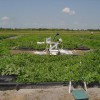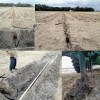 In Florida, watermelon is an important crop that accounts for a significant part of the state’s agricultural water use. Depending on the type of production system and climate, the water use of this crop can vary. In Florida, watermelon is predominantly grown on raised plastic-mulched beds. To develop improved water management and allocation plans, accurate water use estimates for watermelon are needed. Seepage irrigation under plastic mulch is a common production system used to produce watermelon in south and northeast Florida where the water table is shallow. Plastic mulch alters the rainfall entry and soil temperature of the raised beds and can significantly affect evapotranspiration. As there is no information on seepage-irrigated watermelon grown on plastic mulch for subtropical Florida, this 4-page fact sheet summarizes the results from a crop water use study for the seepage-irrigated watermelon in south Florida. Written by Sanjay Shukla and Niroj K. Shrestha, and published by the UF Department of Agricultural and Biological Engineering, August 2014.
In Florida, watermelon is an important crop that accounts for a significant part of the state’s agricultural water use. Depending on the type of production system and climate, the water use of this crop can vary. In Florida, watermelon is predominantly grown on raised plastic-mulched beds. To develop improved water management and allocation plans, accurate water use estimates for watermelon are needed. Seepage irrigation under plastic mulch is a common production system used to produce watermelon in south and northeast Florida where the water table is shallow. Plastic mulch alters the rainfall entry and soil temperature of the raised beds and can significantly affect evapotranspiration. As there is no information on seepage-irrigated watermelon grown on plastic mulch for subtropical Florida, this 4-page fact sheet summarizes the results from a crop water use study for the seepage-irrigated watermelon in south Florida. Written by Sanjay Shukla and Niroj K. Shrestha, and published by the UF Department of Agricultural and Biological Engineering, August 2014.
http://edis.ifas.ufl.edu/ae510
Tag: Subirrigation (seepage) Systems
Water Use for Seepage-Irrigated Pepper with Plastic Mulch in Florida
 Bell pepper (Capsicum annuum) is an important crop for Florida and accounts for a significant fraction of its agricultural water use. Most of it is produced in south Florida, where the water table is shallow. Seepage irrigation is one of the most common systems used in south Florida for growing plastic-mulched vegetable crops, including bell pepper. Compared with an open field production, covering the soil with impermeable plastic reduces soil evaporation and increases transpiration. This 3-page fact sheet summarizes the results from a crop water use study for the seepage-irrigated pepper in south Florida.
Bell pepper (Capsicum annuum) is an important crop for Florida and accounts for a significant fraction of its agricultural water use. Most of it is produced in south Florida, where the water table is shallow. Seepage irrigation is one of the most common systems used in south Florida for growing plastic-mulched vegetable crops, including bell pepper. Compared with an open field production, covering the soil with impermeable plastic reduces soil evaporation and increases transpiration. This 3-page fact sheet summarizes the results from a crop water use study for the seepage-irrigated pepper in south Florida.
Written by Sanjay Shukla, Niroj Shrestha, and Fouad H. Jaber, and published by the UF Department of Agricultural and Biological Engineering, August 2014.
http://edis.ifas.ufl.edu/ae509
Subsurface Drip Irrigation (SDI) for Enhanced Water Distribution: SDI – Seepage Hybrid System (HS1217)
 In terms of water use efficiency, the traditional seepage irrigation systems commonly used in areas with high water tables are one of the most inefficient methods of irrigation, though some irrigation management practices can contribute to better soil moisture uniformity. Subsurface drip irrigation systems apply water below the soil surface by microirrigation, improving the water distribution and time required to raise the water table for seepage irrigation. This 6-page fact sheet was written by Lincoln Zotarelli, Libby Rens, Charles Barrett, Daniel J. Cantliffe, Michael D. Dukes, Mark Clark, and Steven Lands, and published by the UF Department of Horticultural Sciences, March 2013.
In terms of water use efficiency, the traditional seepage irrigation systems commonly used in areas with high water tables are one of the most inefficient methods of irrigation, though some irrigation management practices can contribute to better soil moisture uniformity. Subsurface drip irrigation systems apply water below the soil surface by microirrigation, improving the water distribution and time required to raise the water table for seepage irrigation. This 6-page fact sheet was written by Lincoln Zotarelli, Libby Rens, Charles Barrett, Daniel J. Cantliffe, Michael D. Dukes, Mark Clark, and Steven Lands, and published by the UF Department of Horticultural Sciences, March 2013.
http://edis.ifas.ufl.edu/hs1217